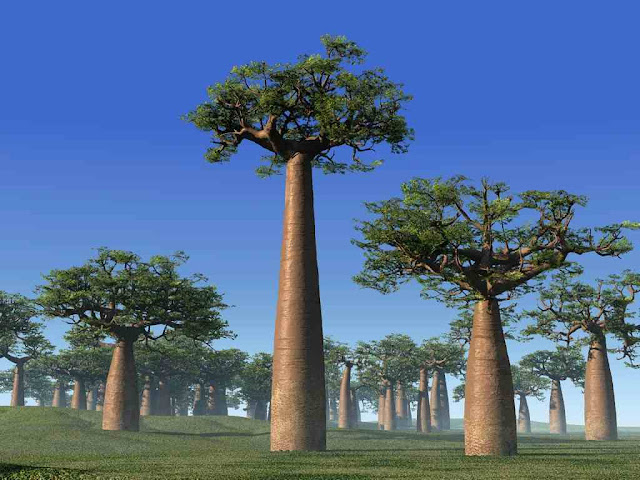Adansonia Grandidieri
Adansonia grandidieri, sometimes known as Grandidier's baobab, is the biggest and most famous of Madagascar's six species of baobabs. This imposing and unusual tree is endemic to the island of Madagascar, where it is an endangered species threatened by the encroachment of agricultural land.
Grandidier's baobabs have massive cylindrical trunks, up to three meters across, covered with smooth, reddish-grey bark. They can reach 25 to 30 m (82 to 98 ft) in height. At certain times of the year the flat-topped crowns bear bluish-green palmate leaves, dark brown floral buds or spectacular flowers with white petals. The large, dry fruits of the baobab contain kidney-shaped seeds within an edible pulp.
This baobab occurs in south-western Madagascar between Lac Ihotry (near Morombe) and Bereboka. Grandidier's baobab used to inhabit dry, deciduous forest, especially near seasonal rivers or lakes. However, today it is mainly found in open, agricultural land or degraded scrubland.
The long-lived Grandidier's baobab is in leaf from October to May, and flowers between May and August. The flowers, said to smell of sour watermelon, open just before or soon after dusk, and all the pollen is released during the first night. The tree is pollinated by nocturnal mammals, such as fork-marked lemurs and insects like the Hawk Moth. The lemurs move through the canopies, inserting their snouts into the white flowers and licking nectar from the petal bases, resulting in pollen being deposited in the lemurs' faces, whereas the moth is slightly more effective at pollination because it is able to fly from tree to tree with most of its body covered in pollen.
The species bears ripe fruit in November and December. Unlike the baobabs of Africa and Australia, it appears that the seeds of the tasty fruit are not dispersed by animals. Lemurs are the only living animals on Madagascar that are capable of acting as seed dispersers, yet seed dispersal by lemurs has never been documented. In the past, however, this could have been very different. There are several species that have gone extinct since human colonization of the island (1,500 to 2,000 years ago) that could very likely have been dispersers of the seeds. This includes species of primates that were thought to be similar to baboons, and the heaviest bird that ever lived, the elephant bird, which had a powerful beak that could have opened large fruit. Today, water may be the means by which the seeds are dispersed.
Lack of water can sometimes be a problem for plants in Madagascar. It appears that the baobab overcomes this by storing water within the fibrous wood of the trunk, as the tree's diameter fluctuates with rainfall.
Explanation from: https://en.wikipedia.org/wiki/Adansonia_grandidieri






Comments
Post a Comment